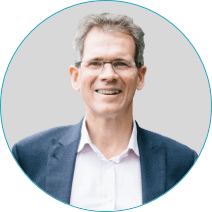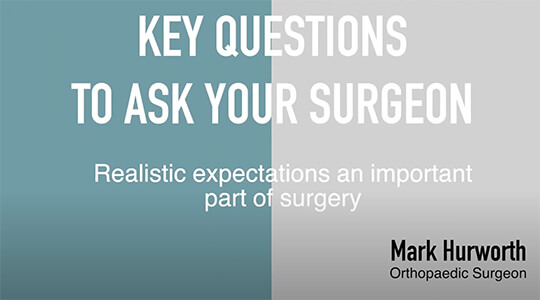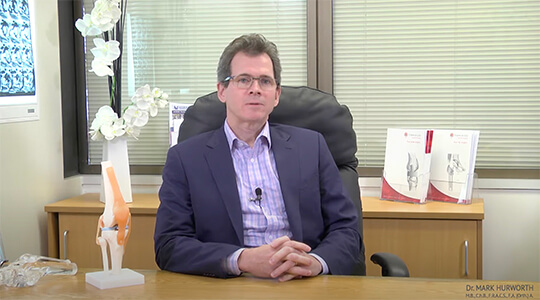Rehab after knee surgery
Rehabilitation for your knee
Orthopaedic surgery relies heavily on patient motivation and compliance. As we discuss below, preparation for and rehabilitation after orthopaedic surgery or injury is about making the right choices and committing to them.

My orthopaedic practice in a nutshell
Exercise after orthopaedic surgery
Quickly regaining movement and why it matters
Your legs are designed to move. Hence, one of the most difficult decisions for me as a surgeon is to restrict motion, mostly in situations where we have to protect the healing process of soft tissue structures such as a meniscal repair in your knee.

Mr Mark Hurworth, Orthopaedic surgeon Perth
Muscles that aren’t used start shrinking and wasting away, sometimes very quickly and dramatically. But the good news is that muscles can be regained, and joints can be retrained. The bottom line is that it requires a lot of effort from your end as the patient.
So the best approach to these issues is perhaps to change the question from “what can I do after surgery?”, rather to: “what can I not do after surgery?”
Whilst a good physiotherapist is invaluable, a sensible question is whether you can just do the exercise required yourself – the answer, of course, is yes.
Here at my orthopaedic practice in Perth, supported by research, we are developing innovative and sophisticated pathways for self-management, remotely monitored and controlled at home, to assist you in improving. These pathways apply in different circumstances:
- Without surgery: This ties in with one of the topics I discuss with patients: ways to avoid orthopaedic surgery.
- Before surgery: The more you get in shape before you have surgery, the quicker you recover, and the less chance of a complication.
- After surgery: This is where our current research focus lies.
The innovative approach makes use of remotely monitored machines with personalised programs monitored by physiotherapists in the comfort of your own home. Only if you are not hitting your targets would a face-to-face physiotherapy service be required.
Best knee exercises
What exercise is best for the knees? What is best avoided?
We are big advocates of closed chain exercise for all knee conditions. These typically involve smooth gliding exercises involving both legs in a circular fashion. Typical closed chain exercise would be:
- Static bike
- Elliptical trainer
- Rowing machine
These exercises are generally safe and build muscle in a controlled environment. We major on static bicycles in my practice as we are developing world-leading technology in this area to monitor and control exercise remotely as a home-based program.
Land-based exercise is best for the legs. This means that water-based exercise, while popular and often social, is not as useful for your lower limb joints and muscles as it does not duplicate real-world conditions. So I would advise you to think seriously about access to a static bicycle if you are having any surgery on the knees and hips. We are always doing research in these areas to try and improve our patients’ performance without, before and after surgery – let us know if you would like to be involved.
Story continues below video gallery
Related videos
Why sleep matters after orthopaedic surgery
The importance of sleep.
It seems logical, but sometimes it is difficult to think straight if you are sleep-deprived. Less sleep, or poor quality sleep, affects other things profoundly, such as pain perception in particular. Therefore, anything that can be done to improve sleep matters. Normally I recommend using natural light where possible ie letting your body rhythms sync with natural light and then timing exercise for first light and last light. Be careful with painkillers such as opiates- they can easily make things worse. Try and take something just before bed for pain if you find the pain is consistently waking you up, and also half an hour before exercise.

Inflammation after orthopaedic surgery
What to avoid during your recovery?
During the first 48-72 hours after surgery I will typically ask you to take it easy, and then gradually increase your exercise intensity after 2 days. This is because there is typically worsening inflammation from the surgery itself in those first 2 days.
In the first 48-72 hours, the acronym is ‘RICE’, which stands for:
- Rest
- Ice
- Compression
- Elevation
Remember, recovery is not a one-size-fits-all package. It all depends on your injury and the surgery that you had. This is just to give you a general idea of your recovery process and we will discuss it in full detail when we prepare your rehabilitation program.
One last thing: beware of opiate analgesia: never let anyone prescribe it for you without a clear plan to come off it! Medically-prescribed opiates are the fastest-growing group of addictions in Australia.
No exercise after orthopaedic surgery
Why should I do anything - isn’t surgery going to fix the problem?
As mentioned above, surgery in orthopaedics is only ever part of the solution. As the patient, you have significant agency in avoiding, preparing for and recovering after surgery.
It can be tempting for some patients to think that they may gain more from a poor outcome after injury than from a successful outcome, especially with compensable injuries. This is a fundamental mistake in thinking – it is simply wrong.
In those that decide not to exercise and not to commit to good outcomes, one thing typically leads to another, and a rabbit hole opens up which descends into passivity and addiction. In particular, becoming dependent on opiate medication is a real risk – medically prescribed opiates are a major and increasing area of addiction. We know that long-term use of opiates makes pain worse, not better.
It won’t come as a surprise to you that it is exactly in this type of situation that we see catastrophic results.
By contrast, we know that a motivated patient can make a big difference, as the chart below illustrates – exercise matters!

Rehab orthopaedic surgeon Perth
Why Mr Mark Hurworth?
I am pretty passionate about rehabilitation, and it seems that most of my patients thrive in an environment where we clearly define what is their responsibility without, before and after surgery. Pain-free recovery of function is the goal of treatment – surgery is best seen as only part of the solution.
My research interests come out of a belief that we have not been very good at measuring the impact of what you do as a patient i.e. what we would call patient agency:
- Your effort
- Your motivation
- Compliance (doing what is recommended)
My experience with many patients here in my orthopaedic practice in Perth keeps confirming it: What you do as a patient often makes a significant difference, almost always more than you think! Most patients want to understand this and that is why our research programs are gaining a lot of interest. The benefit for you as a patient is that we now empower you to manage your recovery in the comfort of your own home with remotely-monitored exercise, collecting data that refines your outcome.
I always welcome your own new ideas to make the most of your rehabilitation, and stories – we love stories!
A Scottish patient told me recently that bending her knee after a knee replacement ‘was like bending a haggis’. It was a new but useful expression. Normally I describe bending after a knee replacement as “bending a balloon – it feels like one side will pop and the other will kink”.
These things are pretty useful to other patients so please keep those stories coming in. We realise that there is a lot we don’t know, and a lot we can improve, so these little things matter!


